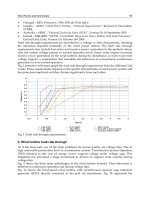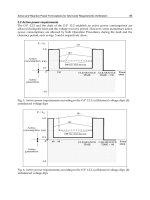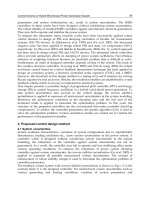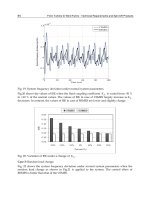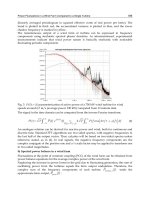From Turbine to Wind Farms Technical Requirements and Spin-Off Products Part 5 ppt
Bạn đang xem bản rút gọn của tài liệu. Xem và tải ngay bản đầy đủ của tài liệu tại đây (404.14 KB, 15 trang )
Active and Reactive Power Formulations for Grid Code Requirements Verification
49
3.2 Active power requirements
The O.P. 12.3 and the draft of the O.P. 12.2 establish no active power consumptions are
allowed during the fault and the voltage recovery period. However, some momentary active
power consumptions are allowed by both Operation Procedures during the fault and the
clearance period, such as figs. 5 and 6 respectively show.
Fig. 5. Active power requirements according to the O.P. 12.3: (a) Balanced voltage dips; (b)
unbalanced voltage dips
Fig. 6. Active power requirements according to the O.P. 12.2: (a) Balanced voltage dips; (b)
unbalanced voltage dips
From Turbine to Wind Farms - Technical Requirements and Spin-Off Products
50
Active power consumptions lower than 10% of installation registered rated power are
admitted during the maintenance of the fault in presence of three-phase balanced voltage
dips, while this maximum allowed magnitude is increased up to 45% of registered rated
power for unbalanced voltage dips, but only during 100 ms (30% each 20 ms cycle). These
active power consumptions referred by the O.P. 12.3 are implicitly defined by (20). The O.P.
12.2 does not express which active power formulation must be used.
German Grid Code is not as exhaustive as the Spanish Grid Code and it specifies wind
farms have the ability of active power curtailment with a ramp rate 10% of grid connection
per minute.
3.3 Current requirements
Spanish and German Grid Codes require the installation supplies the maximum possible
current during the fault maintenance and the voltage recovery period. This current delivery
must verify that reactive current is above the minimum unitary values delimited by the lines
in fig.7, for each grid code.
Fig. 7. Minimum admissible values of the reactive current: (a) O.P. 12.3; (b) O.P. 12.2; (c)
E.ON Netz
Active current limits (in per unit values) according to the O.P. 12.3 are mathematically
expressed in function of the unitary voltage values (V) as:
()
()
()
2
2
1 1 2,57 0,85
1 6,6 0,85 (0,5 0,85)
0 0,4359 (0 0,5)
a
a
a
IV
IVV
IV
≥−+ ⋅−
≤−⋅ − ≤≤
≤≤ ≤≤
(21)
Active and Reactive Power Formulations for Grid Code Requirements Verification
51
Fig. 8. Active current limits in unitary values during the voltage dip
Active current values according to the O.P. 12.2 must be within the area showed in fig.8. Limits
of the active current described in fig.8 are mathematically expressed in unitary values as:
2
() ( 1 )
(1 )
() 0 ( 0,5)
() ( 0,5) (0,5 1 )
(1 )(0,5 )
o
a
a
o
a
P
aI V V V
V
bI V
P
cI V V V
VV
≤≤−Δ
−Δ
≥≤
≥−≤≤−Δ
−Δ −Δ
(22)
where
o
P is the unitary active power supplied by the installation prior to the disturbance.
4. Practical experiences
Two remarkable events occurred in a Spanish wind farm is used in this section to analyze
utility of the active and reactive formulations established in section 2 and their application
for verifying grid code requirements. Those events are a three-phase balanced voltage dip
and a two-phase voltage dip manifested at the connection point of a 660 kW rated power
wind generator, with 690 V phase to phase nominal voltages.
Spanish grid code requirements in their two versions, O.P. 12.2 and O.P. 12.3, were not
verified in the three-phase balanced voltage dip (fig. 9) and the installation was finally
disconnected, mainly due to an excess of the supplied active current (figs. 10 and 11a).
Comparison between active currents measured during the three-phase balanced voltage dip
according to the two approaches included in section 2 (figs. 10 and 11a) shows traditional
active currents used by the grid codes and fundamental positive-sequence active current
have the same evolutions. And the same can be told for the traditional and positive-
sequence reactive currents (fig. 12 and 13a). Active and reactive powers show the same
tendencies and similar values with both theories (figs. 14 and 15, respectively). However,
From Turbine to Wind Farms - Technical Requirements and Spin-Off Products
52
while traditional active and reactive currents have different values in each phase, this one
does not occur with the positive-sequence active and reactive currents; thus, the verification
process of the grid code requirements is easier using the Unified Theory.
Fig. 9. Three-phase balanced voltage dip
Fig. 10. Phase active currents
Active and Reactive Power Formulations for Grid Code Requirements Verification
53
Fig. 11. Unified Theory’s active currents: (a) total, (b) due to the active loads,
(c) caused by the unbalances
Fig. 12. Phase reactive currents
From Turbine to Wind Farms - Technical Requirements and Spin-Off Products
54
Fig. 13. Unified Theory’s reactive currents: (a) total, (b) due to the reactive loads,
(c) caused by the unbalances
Fig. 14. Active powers: (a) Traditional, (b) Unified Theory
Active and Reactive Power Formulations for Grid Code Requirements Verification
55
Fig. 15. Reactive powers: (a) traditional, (b) Unified Theory
Spanish and German grid code requirements was verified by the wind farm in presence of
the analyzed two-phase dip whether the Unified Theory is used. However, the application
of the traditional theory is very complicated since the traditional active and reactive currents
have different sign and value in each grid phases (figs. 16 and 18) and traditional active and
reactive powers contain negative-sequence components. Unified Theory’s positive-sequence
active and reactive currents verify grid code requirements because their values are not
increased during the fault (figs. 17a and 19a). Moreover, the maintenance of the positive-
sequence reactive power is explained by an important consumption of the positive-sequence
reactive current caused by the unbalances (fig. 19c), which compensate the increasing of the
reactive current demanded by the grid (fig. 19b). Figure 20 shows how the duration of
positive-sequence active power consumptions is less than the time period of the traditional
active power consumptions and, thus, the accomplishment of the grid code requirements is
improved. This fact occurs because a short positive-sequence active power delivery caused
by the unbalances (fig. 21b). Difference between the traditional and the Unified Theory’s
reactive powers (fig. 22) defines the negative-sequence component of the reactive power
which originates reverse magnetic fields and causes wind-generator malfunction. Positive-
sequence reactive power is decreased by a strong reactive power consumption caused by the
unbalances during the voltage dip (fig. 23b). This reduction of the positive-sequence reactive
current supplied to the grid is convenient for the accomplishment of the grid code
requirements.
The analysis of the two-phase voltage dip shows the Unified Theory is clearly better than
the traditional theory for verifying the accomplishment of the grid code requirements, since
that theory uses quantities more related with the active and reactive phenomena and it gives
up additional information about those phenomena.
From Turbine to Wind Farms - Technical Requirements and Spin-Off Products
56
Fig. 16. Two-phase voltage dip
Fig. 17. Phase active currents
Active and Reactive Power Formulations for Grid Code Requirements Verification
57
Fig. 18. Unified Theory’s active currents: (a) total, (b) due to the active loads,
(c) caused by the unbalances
Fig. 19. Phase reactive currents
From Turbine to Wind Farms - Technical Requirements and Spin-Off Products
58
Fig. 20. Unified Theory’s reactive currents: (a) total, (b) due to the reactive loads,
(c) caused by the unbalances
Fig. 21. Active powers: (a) traditional theory, (b) Unified Theory
Active and Reactive Power Formulations for Grid Code Requirements Verification
59
Fig. 22. Unified Theory’s active powers components: (a) due to the active loads,
(b) caused by the unbalances
Fig. 23. Reactive powers: (a) traditional theory, (b) Unified Theory
From Turbine to Wind Farms - Technical Requirements and Spin-Off Products
60
Fig. 24. Unified Theory’s reactive power components: (a) due to the reactive loads,
(b) caused by the unbalances
5. Conclusions
The Spanish Grid Code and the grid codes from other countries require some quantities,
such as active and reactive currents and powers, must be controlled in order to avoid
unexpected disconnections of the wind farms submitted to voltage dips. These grid codes
implicitly propose the traditional well-known formulations, included in the IEEE Standard
1459-2010, for measuring active and reactive powers and currents. For balanced voltage
dips, these formulations are adequate to verify grid code requirements, although the
different values of the active and reactive phase currents may difficult the verification
process. However, for unbalanced voltage dips, traditional formulations include
components which are a result of the imbalances and, thus, mistakes in the magnitude and
duration of the active and reactive quantities may be presented.
Fundamental positive-sequence active and reactive formulations, also included in the IEEE
Standard 1459-2010, are a more adequate alternative than the traditional theory for verifying
the accomplishment of the grid code requirements. Several reasons justify the use of the
fundamental positive-sequence quantities: (a) active and reactive currents have only one
component so much for balanced as unbalanced voltage dips and, thus, the verification
process of the grid code requirements is simplified; (b) positive-sequence active and reactive
powers do not contain negative-sequence components caused by the voltage unbalances
and, thus, these quantities exactly quantify active and reactive phenomena effects,
respectively; (c) positive-sequence active and reactive powers and currents can be
decomposed into two components, due to the loads and caused by the unbalances.
Active and Reactive Power Formulations for Grid Code Requirements Verification
61
This decomposition established by the Unified Theory has been expressed in section 2. It
shows how imbalances of supplies and loads originate additional positive-sequence powers
and currents, which either can increase or decrease total values of these quantities and,
therefore, the accomplishment of the grid code requirements can be better explained and
new wind-generator support procedures can be proposed by applying the Unified Theory.
6. References
Emmanuel, A.E. (1999). Apparent Power Definitions for Three-Phase Systems. IEEE
Transactions on Power Delivery, Vol.10, No.3, July, 1999, 767-772, ISSN 0885-8977.
E.ON Netz. (2006). Grid Code: High and extra high voltage. E.ON Netz GmbH, Bayreuth
(Germany), April, 2006.
Kim, H., Blaabjerg, F. & Bak-Jensen, B. (2002). Spectral Analysis of Instantaneous Powers
in Single-Phase and Three-Phase Systems with Use of p-q-r Theory.
IEEE Transactions on Power Electronics, Vol.17, No.5, September, 2002, 711-720,
ISSN 0885-8993.
Industry, Tourism and Commerce Spanish Ministry. (2006). Operation Procedure O.P. 12.:
Response requirements in front of voltage dip at wind farms utilities. BOE 254, 37017-
37019, October, 2006, Madrid.
León, V., Montañana, J., Roger, J., Gómez, E., Cañas, M., Fuentes, J.A. & Molina, A. (2009).
Verification of the Reactive Power Requirements in Wind Farms. Proceedings of
IEEE PowerTech 2009, ISBN 978-1-4244-2234-0, Bucharest, June-July, 2009.
León, V., Montañana, J., Roger, J., Gómez, E., Cañas, M., Fuentes, J.A. & Molina, A.
(2009). Reactive power and current formulations for wind farms Spanish
grid code. Proceedings of EEM 2009, ISBN 978-1-4244-4455-7, Leuven, May,
2009.
León, V., Montañana, J., Roger, J., Gómez, E., Cañas, M., Fuentes, J.A. & Molina, A. (2009).
Estimation of Wind Farms Working in Presence of Voltage Dips Using the IEEE
Std. 1459-2000. Proceedings of PSCE’09, ISBN 978-1-4244-3810-5, Seattle, March,
2009.
León-Martínez, V., Montañana-Romeu, J. (2009). Method and system for calculating the
reactive power in disturbed three-phase networks. PCT/ES 2009/000370, July,
2009.
León-Martínez, V., Montañana-Romeu, J., Giner-García, J., Cazorla-Navarro, A.,
Roger-Folch, J. (2007). Power Quality Effects on the Measurement of Reactive
Power in Three-Phase Power Systems in the Light of the IEEE Standard
1459-2000. Proceedings of EPQU 2007, ISBN 978-84-690-9441-9, Barcelona, October,
2007.
León-Martínez, V., Giner-García, J., Montañana-Romeu, J. & Cazorla-Navarro, A. (2001).
Efficiency in electrical installations. New power definitions. Mundo Electrónico.
No.322, July, 2001, 28-32. ISSN 0300-3787.
Power System Instrumentation & Measurement Committee. (2010). IEEE Std. 1459-2010,
IEEE Standard Definitions for the Measurement of Electric Power Quantities Under
Sinusoidal, Non-Sinusoidal, Balanced or Unbalanced Conditions, The Institute of
From Turbine to Wind Farms - Technical Requirements and Spin-Off Products
62
Electrical and Electronics Engineers, March, 2010, ISBN 978-0-7381-6058-0, New
York.
Spanish Wind Enegy Association. (2008). Offprint of the Operation Procedure O.P. 12.2:
Technical requirements for wind power and photovoltaic installations and any generating
facilities whose technology does not consist on a synchronous generator directly
connected to the grid. Utilities connected to the transport grid and generating
equipement: minimum design requirements, equipment, operation, deployment and
security. www.aeeolica.es.
Part 3
Empirical Approaches to
Estimating Hydraulic Conductivity



